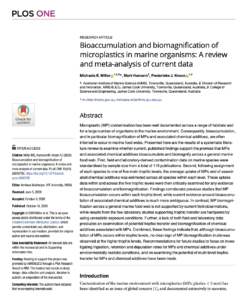This is an explanation of the current understanding about microplastics and additives bioaccumulating in marine organisms, as published in:
Published In: PLoS One
On: Oct 16, 2020

Key Takeaways:
- This is a literature review – the authors reviewed available research on bioaccumulation and biomagnification in marine organisms and summarized their findings.
- Main Findings:
- Bioaccumulation of microplastics (MPs) within each trophic level is confirmed.
- Evidence for the biomagnification of MPs across marine food webs is not supported by current field observations.
Summary
Definitions
- Bioaccumulation: The net uptake of contaminants (like microplastics and chemical additives) from the environment through all possible pathways (e.g., ingestion, contact, respiration). It occurs when an organism absorbs a substance at a rate faster than it can be excreted.
- Biomagnification: The increase in concentration of a contaminant in the tissues of organisms at higher levels in a food chain.
Bioaccumulation
The paper discusses bioaccumulation focusing on microplastics and chemical additives within marine organisms, highlighting:
- The mechanisms of bioaccumulation, including direct ingestion and exposure through the environment.
- The impact of microplastics as vectors for chemical pollutants, emphasizing concerns about their ability to carry harmful substances into organisms.
- The complexity of studying bioaccumulation due to varying factors like organism size, habitat, and exposure levels.
- It advocates for more nuanced research methods to accurately assess the risks and effects of microplastics and associated chemicals on marine life.
Biomagnification
Regarding biomagnification, the paper indicates:
- Current evidence does not support the hypothesis of biomagnification of microplastics (MPs) across marine food webs, based on field observations.
- Laboratory experiments suggesting trophic transfer of MPs have often used conditions that are not reflective of natural environments.
- The paper calls for more realistic environmental simulations in future research to better understand the dynamics of MP transfer across trophic levels.
Additives Associated with Plastics
The paper details on additives associated with plastics and their accumulation, highlighting:
- Bioaccumulation of chemical additives, such as phthalates and polycyclic aromatic hydrocarbons (PAHs), associated with microplastics has been documented in fewer species compared to the bioaccumulation of the microplastics themselves.
- These chemical additives are detected in higher concentrations when exposed to the chemical alone rather than in conjunction with microplastics, suggesting that the presence of microplastics might not always enhance the bioavailability of these chemicals.
- The study underlines the complexity of assessing the environmental impact of these chemical additives, given their varied behaviors and interactions with microplastics in marine ecosystems.
- It emphasizes the need for further research that considers realistic environmental conditions to better understand the dynamics of chemical additive accumulation and their potential effects on marine life.
